Sambo vs BJJ: What’s the Best Form of Grappling?
Sambo and Brazilian Jiu-Jitsu (BJJ) are two distinct martial arts disciplines known for their grappling techniques. Sambo is a Russian martial art known for its grappling and freestyle fighting, whereas Brazilian Jiu-Jitsu (BJJ) is a Brazilian martial art known for its grappling and submissions.
Martial arts fans often compare these styles, and mixed martial arts fighters have had great success with both styles. Notably, many UFC fighters have excelled using both sambo and BJJ techniques. This leaves the question: which one is a better martial art, Sambo vs BJJ? Let’s find out!
A Brief History of Sambo and BJJ
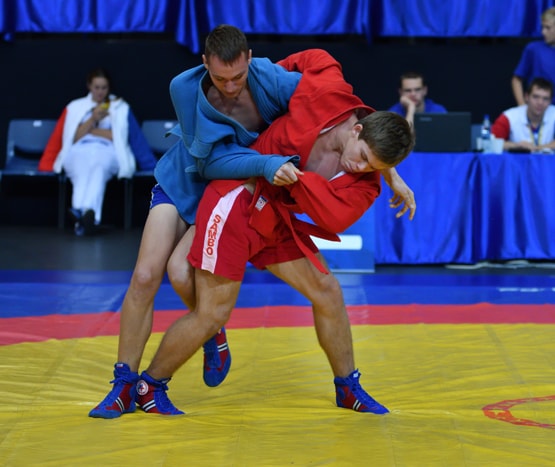
Sambo is a Russian martial art, and it is often known as Russian Sambo. The Soviet Red Army developed it in the 1920s in the Soviet Union to enhance hand-to-hand combat abilities. Notable Sambo world champions like Khabib Nurmagomedov and Ilyas Amosov have significantly contributed to the martial art, showcasing their expertise and credibility through various victories and world championship titles.
Brazilian Jiu-Jitsu (BJJ) is a martial art that originated in Japan and was later developed in Brazil. It was primarily developed by the Gracie family and is well known for its emphasis on ground fighting and submission holds. The sport gained popularity during the Vale Tudo era of freestyle fighting in Brazil. Martial artists would test each other’s skills in the form of Vale Tudo freestyle fighting, and Brazilian Jiu Jitsu fighters would often win.
Sambo and Brazilian Jiu-Jitsu are two popular martial arts with a strong focus on grappling and ground fighting. They have many similar techniques, and both of them were heavily influenced by Judo and Japanese Jujutsu. Early practitioners of sambo and Brazilian Jiu-Jitsu practiced these Japanese martial arts and learned their submission and grappling techniques. This means both Sambo and BJJ have a very similar base, as the inventors of both martial arts initially studied the same Japanese martial arts.
Of course, the pioneers of Sambo and BJJ then went on to refine the techniques they learned and also included their own unique moves. The intention of these grappling arts is to achieve the most efficient takedowns and grappling techniques.
Both martial arts have a great history and have produced many successful fighters in MMA and other combat sports.
Sambo vs BJJ
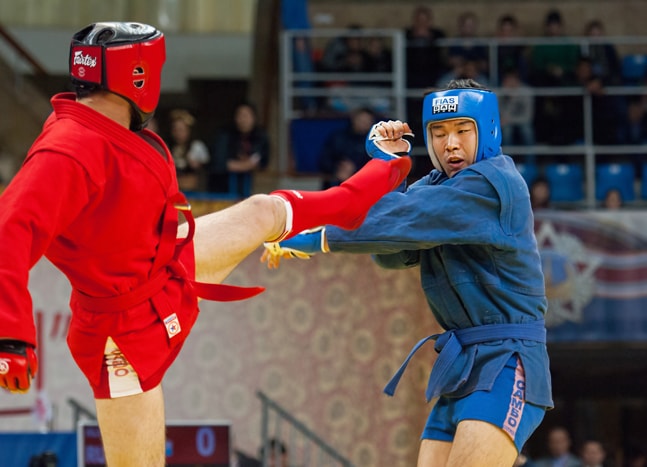
Key features of Combat Sambo
Combat Sambo is a style of Sambo that allows striking and grappling techniques. The rules of Combat Sambo highlight its aggressive nature and emphasize both striking and grappling, distinguishing it from other martial arts like Brazilian Jiu-Jitsu. Combat Sambo practitioners often practice techniques from Muay Thai to enhance their striking skills.
It is a more aggressive style of Sambo that is often called freestyle fighting. Combat Sambo emphasizes finishing the fight quickly and uses techniques from kickboxing, jiu-jitsu, and wrestling. It might look like mixed martial arts as it blends elements of different martial arts together. However, the Combat Sambo rules are different, as they are mostly practiced for competition purposes and not for prize fighting. Even though it is not mixed martial arts, Combat Sambo fighters have transitioned well into mixed martial arts as the techniques are quite similar.
Sport Sambo
Sport Sambo is a style of Sambo that is recognized by the International Federation of Amateur Sambo (FIAS). It is a hybrid martial art that combines elements of judo, jiu-jitsu, and wrestling. It is more similar to Brazilian Jiu-Jitsu than combat sambo is, and these two martial arts are often compared to each other.
Freestyle Sambo
Freestyle Sambo is basically an adaptation of Sport Sambo but with fewer rules. This version of Sambo puts fewer limitations on the types of submission techniques that are allowed, and it has fewer overall rules. Freestyle Sambo and Sport Sambo do not have any striking techniques.
Key features of BJJ
BJJ, or Brazilian Jiu-Jitsu, is a grappling-based martial art that focuses on controlling and submitting opponents. It integrates techniques from other martial arts to enhance its effectiveness and adaptability. It is often called human chess due to the techniques of BJJ being very complex.
BJJ submission techniques are so complex that it can take between ten and twenty years to truly master the martial art. It is a highly specialized martial art that focuses on submission techniques but does not include strikes.
Wrestling techniques are also quite limited in Brazilian Jiu-Jitsu, and the goal of a match is to score points by gaining dominant positions on the mat or to finish the match by submitting an opponent.
Comparing Sambo and Brazilian Jiu-Jitsu
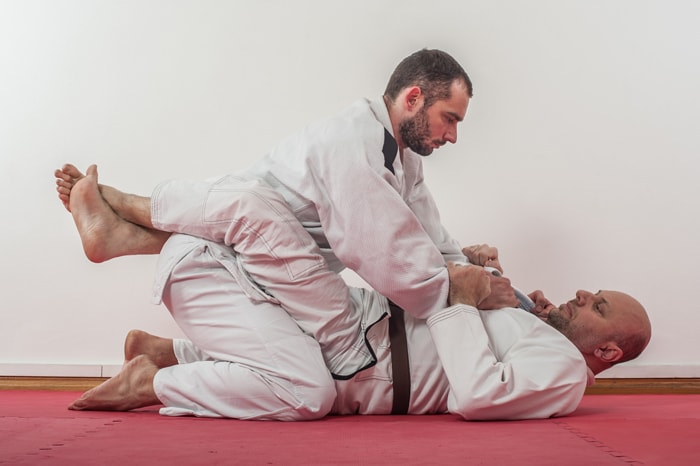
Similarities between Sambo and BJJ
When looking at Sambo vs BJJ, it is important to note the similarities between the two martial arts. Let’s take a look at some of them.
Both Sambo and BJJ are grappling-based martial arts that focus on ground fighting and submission holds.
Both martial arts require high levels of physical fitness and endurance.
Both martial arts have highly effective techniques that are utilized by famous MMA fighters.
Both martial arts are usually practiced for competitions; neither Sambo or BJJ are considered forms of prizefighting.
Key differences between Sambo and BJJ
Now let’s check out what sets them apart.
Combat Sambo allows striking and grappling techniques, while BJJ focuses solely on grappling.
Combat Sambo emphasizes finishing the fight quickly, while BJJ focuses on controlling and submitting opponents.
Combat Sambo is viewed as a type of freestyle fighting style, while BJJ is viewed solely as a grappling martial art.
Combat Sambo utilizes advanced wrestling takedowns and Judo-style throws, while BJJ uses basic wrestling takedowns.
Winning objectives and rules in Sambo and BJJ
In Sambo, the objective is to score points or submit your opponent.
In Combat Sambo fighters can score knockouts too, which is a big contrast to BJJ.
In BJJ, the objective is to submit your opponent or gain a point advantage.
Practical Applications
How Sambo and BJJ can benefit MMA fighters
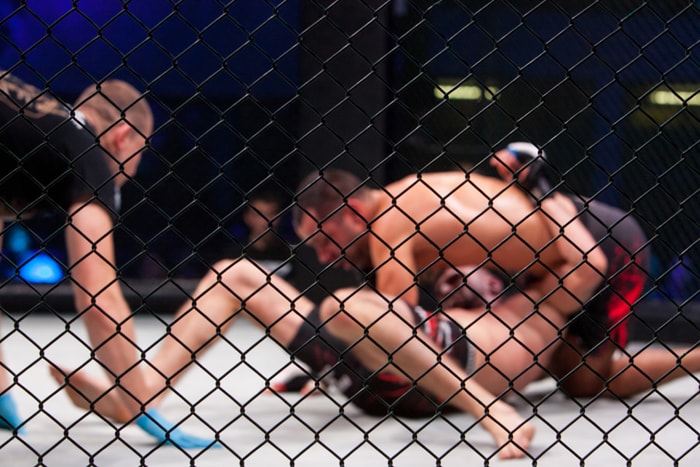
Both Sambo and BJJ can improve an MMA fighter’s grappling skills and ability to finish fights with submissions. Sambo world champions have demonstrated their prowess in MMA, achieving notable success and recognition. Many UFC fighters have backgrounds in Sambo and BJJ, showcasing the effectiveness of these martial arts in the octagon.
Many successful MMA fighters, such as Fedor Emelianenko, Khabib Nurmagomedov, and Islam Makhachev, have come from Sambo backgrounds. These fighters have had very successful MMA careers, and many MMA fans consider them to be elite champions.
When it comes to successful MMA fighters with Brazilian jiu-jitsu backgrounds, there are even more than the Sambo-based fighters. This is because BJJ is the must-learn sport for most MMA fighters, whereas Sambo is usually learned by Russian fighters. Sambo is a Russian martial art, which means it is not popular worldwide, and many MMA fighters don’t have access to it.
Overall, both have proven to be extremely effective for MMA; however, Sambo teaches a wider variety of techniques, and Brazilian Jiu Jitsu is more specialized for ground fighting techniques.
Factors to consider when choosing between Sambo and BJJ
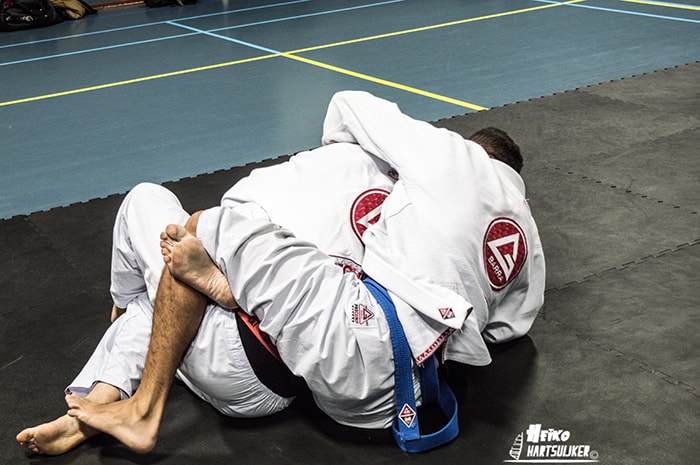
When choosing the right martial art, it is important to consider your goals and what you want to achieve through training. Think about your personal preferences and what style of martial art you enjoy the most. If you enjoy purely grappling-based martial arts, then BJJ is the right way to go, but if you would like more freedom to use different techniques, then Sambo teaches that well.
Research local gyms, and instructors can also help you choose. Sambo might be more difficult to find, as it is a Russian martial art that is not as popular worldwide. BJJ will probably be more accessible as it is extremely popular and a good academy can be found in most major cities.
Factors to consider when choosing between Sambo and BJJ
When choosing the right martial art, it is important to consider your goals and what you want to achieve through training. Think about your personal preferences and what style of martial art you enjoy the most. If you enjoy purely grappling-based martial arts, then BJJ is the right way to go, but if you would like more freedom to use different techniques, then Sambo teaches that well.
Research local gyms, and instructors can also help you choose. Sambo might be more difficult to find, as it is a Russian martial art that is not as popular worldwide. BJJ will probably be more accessible as it is extremely popular and a good academy can be found in most major cities.
Conclusion
Combat Sambo seems to be the more complex fighting style overall. However, if we compare BJJ to Sport Sambo and Freestyle Sambo, we find that they have very similar techniques. BJJ places less emphasis on wrestling and Judo techniques, which, in my opinion, makes it a slightly less effective martial art than Sambo.
The effectiveness of the martial art does depend on the overall level of the practitioner; this means a high-level BJJ fighter would likely defeat a mid-level Sambo fighter and vice versa. Whichever you choose to practice, both martial arts are very effective and take years to master, so good luck on your journey!
Frequently Asked Questions
What is the closest thing to Sambo?
Brazilian Jiu-Jitsu is the closest thing to Sambo; it includes similar techniques and some of the same rules.
Did Khabib practice Sambo?
Yes, Khabib practiced sambo and was highly proficient in the martial art. His Sambo career started well before his MMA career.
What is Sambo in martial arts?
Sambo is a Russian martial art that includes wrestling, judo, and submission techniques. Combat Sambo also includes striking techniques from kickboxing and boxing.
Why is combat Sambo so good?
Combat Sambo is a great martial art, mostly because of its versatility. Techniques from various martial arts are used in Combat Sambo, which makes it an effective form of freestyle fighting.









